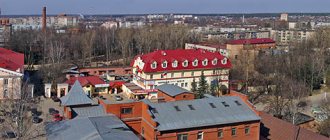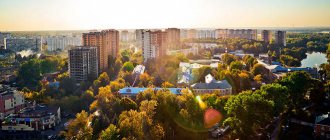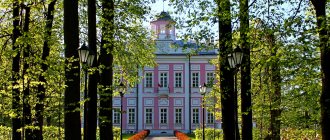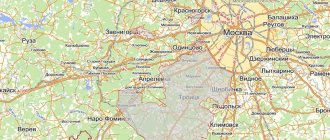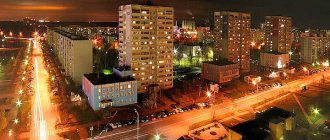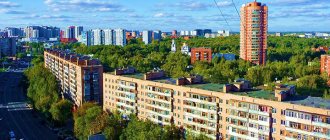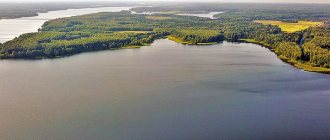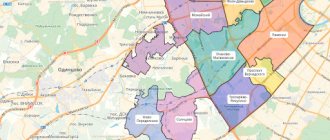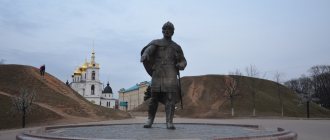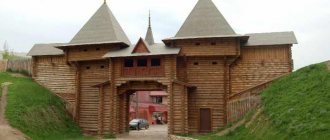We continue to talk about the cities of the Moscow region. Today, next in line is Dmitrov , founded by Prince Yuri Dolgoruky in 1154. Dmitrov was named after the youngest son of Yuri Dolgoruky - Vsevolod the Big Nest (at baptism he received his second name - Dmitry), who was born in the same 1154. During its history, the city was part of the Pereyaslavl Principality, the Vladimir-Suzdal Principality, the Galicia-Dmitrov Principality, the Dmitrov Principality and, finally, the Moscow Principality. On the way of the Mongol-Tatar raids on Rus', Dmitrov was defeated and burned several times. Now 66 thousand people live in Dmitrov, for the 850th anniversary of the city (by 2004) a large-scale improvement project was carried out for the city, in 2008 the city was awarded the title “City of Military Glory”. The Dmitrov Kremlin and the Boris and Gleb Monastery are the main one-day tourist routes.
Dmitrov Kremlin
The Dmitrov Kremlin was built in the 12th century as an ancient Russian border fortress. Nowadays there is a museum-reserve on this site, which includes 12 buildings (six of which are located on the historical square). The museum's fund includes about 40 thousand storage units.
Dmitrov's Zemlyanoy Val
The museum gates are open from 10 am to 5 pm; Closed: Monday and Tuesday. But even if you arrive outside of working hours, do not despair, because the entire territory of the Kremlin can be viewed from the once defensive embankments of the 12th century, closed around the Kremlin. The total length of the shafts is 990 meters, and the maximum height is 14 meters. Once on the ramparts there were wooden walls and towers of the Kremlin, which were not preserved due to frequent wars and fires. The Kremlin's earthen rampart is protected by the state.
Alexander Chapel
Or the chapel of Alexander Nevsky, the patron saint of all warriors. It was built in 1868 at the expense of the townspeople in honor of saving the life of Emperor Alexander II from an assassination attempt in 1866. The chapel is installed outside the Kremlin, in front of the Nikolsky Gate.
Nikolsky Gate
Nikolsky Gate (travel Nikolskaya Tower), was considered the main entrance to the Dmitrov Fortress from the north-western side and was burned in 1610 during the Time of Troubles, like the other 9 towers with a defensive wooden wall. The current wooden Nikolsky Gate was built in 2004, after which it burned and was restored several times.
Assumption Cathedral in Dmitrov
The architectural dominant of the Dmitrov Kremlin is the Assumption Cathedral. The cathedral was rebuilt several times, as a result of which it received 9 chapters (initially there were 5). The exact date of construction of the cathedral is unknown, approximately between 1509 and 1533. From 1932 to 1991 the temple was closed and transferred to the museum, the crosses were removed and the dome and spire of the bell tower were dismantled. In 2003, the temple and bell tower were completely restored and restored.
Gilded five-tiered iconostasis from the late 17th century.
Walking path from St. Nicholas Gate to the Assumption Cathedral.
In 2010, in front of the entrance to the Assumption Cathedral, a monument was erected to the Holy Martyr Seraphim, Bishop of Dmitrov. Bishop Seraphim served in the Assumption Cathedral of Dmitrov from 1920 to 1923. During this time, he founded the Brotherhood of the Life-Giving Cross of the Lord and was engaged in counter-revolutionary activities, for which he was sent into exile, and on August 23, 1937 he was sentenced to death.
A monument to the brothers Cyril and Methodius, who are known as the creators of the Slavic alphabet, was erected here in 2004. Cyril is holding a scroll with the Cyrillic alphabet in his hands, and Methodius is holding the Gospel.
Their image can also be seen inside the Assumption Cathedral on the wall.
Assembly of the Nobility
The building was built between 1877 and 1888. to accommodate military units stationed in the city. It became the building of the noble assembly a little later: in 1897. After the revolution of 1917, party and public organizations began to be located here: the Red Army club of the Dmitrov garrison named after Semenyuk, the party club, library and circles. After a fire in 1921, the second floor completely burned down, which was restored only in 2003. All this time, the remaining first floor was used as a school, workshops, and warehouses, until it fell into disrepair. Now the restored building is used by the museum to house art exhibitions.
Elizabethan Church
The Church of St. Elizabeth was built in 1898 and was assigned to the city prison, which is why the windows were reinforced with metal bars, and there was a balcony for guards on the second floor. Elizaveta Semyonovna Lyamina (wife of the owner of the Yakhroma spinning and weaving factory) donated funds for the construction of the church. In 1925 the church was closed and used as a village club and then as a storage building. In 1998, the church was returned to the Orthodox Church.
Prison building and outbuilding
The prison for which the Elizabethan Church was built is located right there (pictured in the center). The building was built at the beginning of the 19th century and served as a prison until the beginning of the 20th century. Later, the building housed: an improvement plant of the Executive Committee of the City Council, a funeral supplies store, and a laundry collection point. In the early 1980s. the building was transferred to the museum.
The outbuilding (two one-story extensions on the sides of the prison) was used as administrative buildings for the prison. Later the premises were converted into apartments for prison servants. Now the buildings have also been transferred to the museum, where museum funds are stored.
Gymnasium
The women's gymnasium (4 junior classes) was built in 1876 on the orders of Emperor Alexander II; girls from the most noble families of Dmitrov studied there. Along with it, six more new gymnasiums were built in Dmitrov. After 30 years, the pro-gymnasium was transformed into a full gymnasium with an 8-year course of study. There were 198 girls in seven subject classes, eight additional and two parallel preparatory classes. The gymnasium was financed from the city budget.
Behind the gymnasium there is a streetball court.
Parochial school
A former parochial school, it now houses the “Russian House” center for the development of creativity for children and youth.
Sports and life after sports in Dmitrov
At one time, the city of Dmitrov was an ordinary town in the north of the Moscow region. No one was particularly interested. But at the very beginning of the 21st century, the Russian government became interested in alpine skiing and decided to organize the Alps at its side. I think that because of the acceptable mountain landscape, the choice fell on the Dmitrovsky district, especially since there were already some developments in skiing.
In the village of Yakhroma, near Dmitrov, a ski resort was organized. And things went well. Many bigwigs began to rest physically and mentally there. Restaurants, hotels, banquet halls, clubs, SPA centers and, of course, high-quality trails were built and equipped with the latest technology. The city and region lived happily ever after. I know for sure that during the crisis, when the district was unable to pay for electricity, its debt was written off in whole or in part. What can you not do because of your love for skiing and a healthy lifestyle!
During this time, sports facilities were opened not only in Yakhroma. In Dmitrov itself, a huge full-service fitness center and several ice palaces for various sports were built.
One of the ice palaces. Photo by https://fotki.yandex.ru/users/polk51890/
And all this was followed by the opening of numerous sportswear stores. In a city with a population of 60,000 people, there are more than fifteen sports equipment and ammunition stores! Now they are slowly starting to repurpose themselves into grocery departments.
And then the rulers’ love for Dmitrov and for sports near Moscow faded a little. The district is no longer so generously funded. And many large objects have already been set up! It seems like it's good, but it's not all that beautiful. In order to adequately maintain buildings, complexes, roads and other infrastructure, a constant influx of funds is needed. The district ran out of money. Many private owners closed shops and factories and began renting out premises. Only one plant remained operational in the city. With Yakhroma everything is not so sad. Dmitrov residents and Muscovites still go there on weekends to barbecue and ski.
I'm a young girl. I love shopping, but in Dmitrov, apart from sportswear, there are practically no normal clothing stores. There is one large shopping center in the city, but you can walk around it in 10 minutes and not find anything interesting. There are several brand stores with medium and low prices for outfits, but they do not bring new collections. Everyone goes to Moscow to buy clothes. And at work too!
Shopping arcades in the city. Photo by jul-karina (https://fotki.yandex.ru/users/jul-karina/)
Electric trains run every hour to Savyolovsky station. But you can get to the capital by car without traffic jams only at night or early in the morning. The road to Dmitrov has been undergoing major repairs for several years now. It is not being expanded, but additional interchanges and overpasses are being made. If you need to get to Moscow during the day, then the average speed will be no more than 12 km/h. But we have to go! Without visiting the capital's shopping centers, including grocery stores, it is difficult to live in a small town with low salaries. It is considered good if you receive 20,000 rubles.
In general, many of my friends began to buy goods in online stores. They order delivery to Savelovsky Station, go there by train and pick up what they bought. Online stores do not like to deliver purchases to Dmitrov. The road is crooked, with traffic jams and populated areas. If they take delivery, the price will be so high that you will think 10 times about the need for such a service.
Historical square. Photo by jul-karina (https://fotki.yandex.ru/users/jul-karina/)
For entertainment, there are cinemas, one theater, a historical landmark, 3 clubs, several cafes and restaurants. In good weather, everyone walks around the center and in the grove. In summer there is nowhere to swim, unless you find some small pond. The Moscow Canal runs near the city, but it is not suitable for swimming.
A lot of people go to work at Sheremetyevo Airport or Moscow. Some people take their children to study in Moscow schools, gymnasiums or lyceums. In Dmitrov itself there is a real problem with higher educational institutions. You can get a higher education in just one institution. Again, young people leave for the capital and then don’t come back. There are simply no young teachers and doctors in the city. On the one hand, it’s good that mostly experienced specialists treat and teach. What to do when they all retire? Of course, they will find someone to take the place of teachers and doctors, but who it will be is unclear. Young people are eager to go to Moscow! The city of Dmitrov is turning into a kind of village where parents live and are waiting for their children for the weekend. And parents with small children who, already in high school, begin to study in Moscow schools.
And Muscovites began to move here. A village of town houses was built in the city. Residents of the capital very quickly bought up the houses there. In general, there are no huge problems with housing in the city. Several new buildings have been launched. It's nice that the historical center is not being touched. The city is growing in width due to the annexation of the outskirts and nearby settlements.
New buildings are in the background. Photo by jul-karina (https://fotki.yandex.ru/users/jul-karina/)
Housing is housing, but there are difficulties with transport. I can’t imagine how to live in Dmitrov without a car. There are few minibuses, buses run on such a tricky schedule that not everyone can understand it. There are taxi drivers. Several times, when calling a taxi, I personally heard a negative answer to the question of whether it was possible to call a car. Sometimes you have to wait in line for up to 2 hours. And this is not on holidays! In short, buy a car and you will be happy. It’s just better to take it with a good suspension. After all, Dmitrov is Russia, and the roads here are Russian...
Traffic jams are insignificant compared to the capital's congestion. Usually, they are only in two places. They even make me smile. It's nice that people in Dmitrov started driving around in cars. It’s okay to live in the city if the salary is good. Traveling to work in Moscow and spending the night in Dmitrov is very exhausting and unsettling. Many people give up and calm down after 2-3 years of such a race. After such an experience, someone is trying to open something in the city. As an example, I can cite the fact that there are so many small hairdressing salons in Dmitrov that only Paris has more of them. The level of service there leaves much to be desired, but the prices for services compensate for the inconvenience.
The city itself is not particularly beautiful. There are many Soviet buildings, the roads are narrow and full of potholes. True, it’s easier to breathe than in the capital. There are fewer people and there are no factories left. That is how we live. We secretly dream of Moscow, but at the same time we remain provincial.
Sovetskaya Square (formerly Upper Trading Square)
In front of the Dmitrov Kremlin lies Sovetskaya Square with a small walking alley. The square was also called Upper Trade Square and Revolution Square. The square received its current name in the 1920s, in connection with the Council of Workers', Peasants' and Soldiers' Deputies located here, and then the District Council.
Along the street there are buildings with shops, trading houses and cafeterias. It is worth noting that the entire area around the Kremlin is kept in perfect order, all thanks to the reconstruction of the city for the 850th anniversary (by 2004). For some reason, in Russia, cities look good only on anniversaries or before important competitions. They worked so well on Dmitrov that in 2005 the city took first place in the All-Russian competition “The most comfortable city in Russia” in the category “Up to 100 thousand inhabitants.”
The square is decorated with several fountains; on holidays, a stage is immediately installed.
Monument to Yuri Dolgoruky in Dmitrov
The main attraction of Sovetskaya Square is the monument to Yuri Dolgoruky, the founder of the city. According to legend, the monument is located in the very place where Yuri was predicted the birth of his son, after which he ordered the foundation of a city on this land. The monument was erected in 2001 as part of the same preparations for the city’s anniversary. Yuri Dolgoruky is “standing” with his back to the southern entrance to the Kremlin. Initially, this entrance did not exist; it was cut at the end of the 19th century.
On the opposite side of Sovetskaya Square there is a monument to V.I. Lenin (installed in 1950). It’s funny that the two leaders look and point with their right hands at each other; this can only be seen in Dmitrov.
Zagorskaya street in Dmitrov
An eternal flame burns not far from the southern entrance to the Kremlin. The Eternal Flame memorial was installed at the end of 2001 on the site where the T-34-85 tank previously stood (the tank has now been moved to the exit from the city). Traditionally, the names of those killed during the Great Patriotic War are carved on a granite pedestal.
A little further: a park with a fountain.
Across the road is a residential building with a drawing calling for peace among all peoples.
Zagorskaya Street leads directly to the main building of the Museum and Exhibition Complex, which includes the Dmitrov Kremlin. The building was opened in 2004 on the site of an ancient settlement. The building houses exhibition halls, fund storage facilities and administrative premises, circles and clubs.
There is also a walking park with fountains.
Zagorskaya Street ends with the Constellation Palace of Culture: a yellow building with columns in the style of Soviet neoclassicism. The building houses the municipal theater “Bigger Nest”, where author exhibitions, concerts, creative meetings, theatrical performances, official events and city holidays are held.
Dmitrov today
One of the most ancient cities in the Moscow region has a thousand-year history, imprinted in architectural monuments. The domes of nine ancient churches dominate the historical center of the city, overshadowing all residents with their holiness.
The main shrines of the city: the Dmitrov Kremlin and the Boris and Gleb Monastery are well known not only in the Moscow region, but also everywhere where Russians live. Hoary antiquity is revered and lovingly preserved, but this is history, and modernity is presented closer to the outskirts, where new houses are being built day by day. The modern architecture of Dmitrov is no less interesting and multifaceted.
Just like in other areas of the Moscow region, the housing construction boom in the city occurred at the beginning of the new millennium. During this time, dozens of projects have been implemented that have allowed the majority of citizens to significantly improve their quality of life.
Kropotkinskaya street in Dmitrov
In 2003 (of course, for the 850th anniversary of Dmitrov), the pedestrian part of Kropotkinskaya Street on the eastern side of the Kremlin was improved: paved, houses were restored, lawns were tidied up, sculptures and monuments were installed.
View of Kropotkinskaya Street from the embankment.
At the very beginning of the street there is a monument to Peter Alekseevich Kropotkin (1842-1921), a Russian prince, scientist and revolutionary. P. A. Kropotkin was a researcher of the tectonic structure of Siberia and Central Asia. Famous historian, philosopher and publicist, creator of the ideology of anarcho-communism and one of the most influential theorists of anarchism. Behind him is the house of the merchant Novoselov . The Novoselov family was the most numerous in Dmitrov; it dates back to the 17th century, and by the end of the 19th century more than 10 Novoselov dynasties already lived in Dmitrov. Such a large family occupied several houses on the street, but to this day only one house, built in 1842, has survived.
The remaining sculptures on Kropotkinskaya Street are not tied to any individuals; they are designed to reflect the life and way of life of the city in the 19th century. A couple of young nobles walking along the Kremlin. By the way, here is the third (eastern) entrance to the Dmitrov Kremlin. When the Yegoryevskaya Tower passage stood at this place.
A merchant with a merchant's wife. The merchant has in his hand a wonder of that time - a watch.
Female teacher with magazines and ruler.
Bearded pilgrim with a staff.
Peasant woman with a cat.
If you have time, check out the “Tourist's Dream” gallery on the same street. In fact, this is a store, but also a free museum of various gizmos. Here you can see original works (dolls, interior decorations, dishes, etc.) made by masters of the Dmitrov region; exhibitions of collectors, artists and textile workers. You can also order a guide around the city or a master class (of course, for a fee).
Chess: red pieces are Rus', and black pieces are Tatar-Mangols.
Dmitrov
Kremlin, Assumption Cathedral
© Oleg N.
Dmitrov near Moscow is located 50 km from the Moscow Ring Road. Just a half hour drive, and from the bustle of metropolitan life you find yourself in a quiet ancient city, decorated with stone temples and merchant houses. Dmitrov is only two years older than Moscow and was also founded by one Grand Duke Yuri Dolgoruky in honor of the birth of his son. The centuries-old history of the city is reflected in its architectural appearance, so many tourists not only from Russia, but also from other countries strive to come here.
The city saw many battles; foreigners from the Mongols to the Nazis tried to capture it. But Dmitrov survived, rebuilt after the fires, and traded. Gingerbread cookies were baked here, which were equally famous as those from Tula. In the thirties of the 20th century, the Moscow Sea appeared near Dmitrov, dug by Gulag prisoners. Since then, the city has become a cargo port. Not far from Dmitrov there are several ski centers near Moscow, where there are many different trails for skiing, snowboarding and sledding. The height of the local trails is not so high, but their modern equipment and developed infrastructure make these places very popular.
Among the most famous residents of Dmitrov is Pyotr Kropotkin, scientist, philosopher, publicist, and founder of the ideology of anarchism. He is also known for his geological and geographical works. In the house of Count Olsufiev, where Pyotr Alekseevich lived in the last years before his death, there is now a museum of the famous anarchist. One of the central streets of the city, on which a monument to Pyotr Alekseevich was erected, also received Kropotkin’s name. Prince Kropotkin is depicted as an elderly man with a thick beard, sitting on a bench like an old man. But his tenacious gaze and ironic smile show that this man is not a simple man in the street, but one of the ideologists of a socio-political movement popular in the 19th century.
Rose garden on the territory of the Kremlin
© Oleg N.
Kropotkinskaya Street, which runs past the ancient Dmitrov Kremlin, is decorated with the sculptural group “Citizens”. Here, almost in the middle of the paving stones, there are life-size bronze figures of people dressed in an ancient dress of the 19th century. The creators of the sculptures, Alexey Karaulov and Galina Gulyaeva, made generalized images of the inhabitants of the old city. A merchant couple, a young teacher, an old man with a stick, nobles and a simple townswoman help to feel the spirit of the times, taking us back to the past.
The central place of the city is the Dmitrov Kremlin, a former defensive structure that served to protect the country's borders from attacks by foreign invaders. Today, the rampart that surrounded the Dmitrov Kremlin has been partially preserved. The height of the protective shaft, of course, decreased over time. Previously, there were protective walls with a dozen watchtowers on it. The walls were destroyed after the Polish-Lithuanian occupation and were never rebuilt. Previously it was possible to get here through the Yegoryevsky and Nikolsky gates. They were destroyed during the Time of Troubles. And in the 19th century, another passage appeared in the Kremlin. In 2004, a special wooden arch was created on the site of the Nikolsky Gate.
On the territory of the Kremlin there are several buildings that are part of the structure of the Dmitrov Kremlin Museum-Reserve. Here is the Cathedral of the Assumption of the Blessed Virgin Mary, dating from the beginning of the 16th century. It is assumed that the Assumption Cathedral was built by Italian craftsmen, like several Moscow churches. The Dmitrov Kremlin also includes the Elizabethan Church, the building of the former noble assembly, a women's gymnasium, the building of a former prison and other houses.
Boris and Gleb Monastery
© Margarita Kushnirenko
Another decoration of Dmitrov is the Boris and Gleb Monastery, known since the mid-15th century. The central point of the monastery was the cathedral in honor of Saints Boris and Gleb. Here, near the walls of the monastery, there is also a monument in honor of the saints. Since the 18th century, the monastery has been surrounded by a four-meter-high fence with corner towers. Royalty also took an active part in the history of this place. By decree of Tsar Alexei Mikhailovich, the monastery became the Moscow residence of his friend and confessor, Metropolitan Nikon. A religious school was also located on the territory of the monastery. During Soviet times, the monastery was given over to the management of the Dmitrov forced labor camp. At the same time, the monastery lost many of its shrines and interior decoration. The revival of the monastery began in the nineties of the last century.
Among the attractions located near Dmitrov, you can visit the village of Orudevo. This is a former testing ground where the world's only combat vehicle, created by Nikolai Lebedenko in 1915, was tested. The tank had two wheels with spokes, the diameter of which was 9 m. The machine-gun cabin was located at a height of 8 m above the ground. The tank was armed with two guns and several machine guns. It was assumed that the speed of the car could be 18 km/h. But already the first test of the tank revealed a number of design flaws. Due to the weight and improper alignment, the car got stuck in the ground. The design of the wheels turned out to be vulnerable to artillery fire. After unsuccessful tests, the Tsar Tank remained at the training ground, where in the twenties it was cut into pieces.
Museum and exhibition complex
© Oleg N.
Not far from Dmitrov is Peremilovskaya Heights, where bloody battles took place in 1941, reversing the fascist offensive. For two days, a small group of Red Army soldiers defended this bridgehead from the advance of the famous 7th Tank Division of the Germans. The occupiers were thrown back, thereby preventing the ring from closing around Moscow. And although there were still three long years left before victory, at Peremilovskaya Heights the course of the war began to reverse. A monument was erected at the site of the battles in 1966 - a soldier of victory, a liberating warrior who destroyed the brown plague, rises above the surrounding fields and forests.
You can get a lot of information about the city in a compressed format at the Dmitrov Museum of Local Lore, opened at the beginning of the twentieth century - in 1918. The exhibits include estate and household items from different times, examples of fine, as well as decorative, folk and temple art, photographs and even video materials. If we talk about the Moscow region, then the collection of the Dmitrov Museum can be called one of the most representative and interesting for the viewer. There are guided tours around the museum, and the museum building itself, in the spirit of classical baroque, is very interesting architecturally and definitely attracts the eye.
Other sights of Dmitrov worthy of attention:
- Monument to Yuri Dolgoruky
- Time Box Museum
- Kazan Church
- Sretenskaya Church
- Monument to Dmitry Solunsky
- House of Klyatovs
- Fountain "Waiting"
- Monument to Seraphim Dmitrovsky
Boris and Gleb Monastery
History has not preserved the exact date of creation of the Boris and Gleb Monastery; its oldest buildings date back to the 15th-16th centuries. The earliest mention of the monastery is indicated in the will of Prince Yuri Vasilyevich in 1472. The Boris and Gleb Monastery was repeatedly attributed to the composition of other monasteries. In 1682 they wanted to assign him to the Zaikonospassky Monastery, but the addition did not take place. From 1724 to 1726 was assigned to the Novgorod Bishops' House. Since 1764, the Boris and Gleb Monastery remains the only monastery in Dmitrov (Pyatnitsky and Nikitsky were abolished). Since 1926, the monastery has been closed and given to the local history museum. Since that time, the monastery has housed: a GULAG department for the construction of the Volga-Moscow canal, a military unit and various other organizations. Restoration of the monastery began in 1993; by 2004 it was completely restored and re-consecrated.
In 2006, a monument to princes Boris and Gleb was erected near the walls of the monastery - the first Russian saints, protectors of the Russian land and heavenly helpers of the Russian princes. Boris and Gleb were the sons of the Kyiv prince Vladimir Svyatoslavich (Vladimir the Red Sun), and were killed by their older brother Svyatopolk the Accursed.
The stone Cathedral of Boris and Gleb is the oldest building on the territory of the monastery and the center of the entire composition. In the 17th century, a three-tier hipped bell tower was added to it.
The Chapel of the Descent of the Holy Spirit was built next to the cathedral in 2004.
The Gateway Church of St. Nicholas was built under Archimandrite Kallistrat in 1685-1687 over the Holy Gates.
Abbot's house from the 19th century.
Monastic poultry house, also known as an aviary for peacocks. In the warm season, peacocks walk around the monastery!
